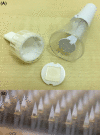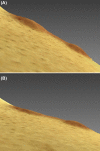Dissolving Triamcinolone-Embedded Microneedles for the Treatment of Keloids: A Single-Blinded Intra-Individual Controlled Clinical Trial
- PMID: 31376063
- PMCID: PMC6704225
- DOI: 10.1007/s13555-019-00316-3
Dissolving Triamcinolone-Embedded Microneedles for the Treatment of Keloids: A Single-Blinded Intra-Individual Controlled Clinical Trial
Abstract
Introduction: Keloids are a prevalent chronic skin disorder with significant psychosocial morbidity. Intralesional corticosteroid injections are the first-line treatment but are painful and require repeated injections by medical professionals. Dissolving microneedles are a novel method of cutaneous drug delivery that induces minimal/no pain and can be self-administered. The objective of the study was to evaluate the efficacy and safety of triamcinolone-embedded dissolving microneedles in treatment of keloids.
Methods: This was a single-blind, intra-individual controlled two-phase clinical trial of 8-week duration each. Two keloids per subject were selected for (1) once-daily 2-min application with microneedles for 4 weeks, followed by no treatment for the next 4 weeks, or (2) non-intervention as control. Primary outcome was change in keloid volume as assessed by a high-resolution 3D scanner.
Results: There was significant reduction in keloid volume compared with controls after 4 weeks of treatment. This reduction was greater with a higher dosage of triamcinolone used.
Conclusions: Once-daily application of dissolving triamcinolone-embedded microneedles significantly reduced the volume of keloids. The treatment was safe, can be self-administered and can serve as an alternative for patients unsuitable for conventional treatments.
Trial registration: Trial Registry: Health Science Authority (Singapore) Clinical Trials Register Registration number: 2015/00440.
Keywords: Keloids; Microneedles; Scars.
Conflict of interest statement
The authors Colin WX Tan, Wei Ding Tan, Ruchir Srivastava, Ai Ping Yow, Damon WK Wong and Hong Liang Tey have nothing to disclose.
Figures



Similar articles
-
Efficacy of a triamcinolone acetonide-loaded dissolving microneedle patch for the treatment of hypertrophic scars and keloids: a randomized, double-blinded, placebo-controlled split-scar study.Arch Dermatol Res. 2023 May;315(4):989-997. doi: 10.1007/s00403-022-02473-6. Epub 2022 Nov 16. Arch Dermatol Res. 2023. PMID: 36383222 Clinical Trial.
-
Intralesional cryotherapy versus excision with corticosteroid injections or brachytherapy for keloid treatment: Randomised controlled trials.J Plast Reconstr Aesthet Surg. 2018 Jun;71(6):847-856. doi: 10.1016/j.bjps.2018.01.033. Epub 2018 Feb 6. J Plast Reconstr Aesthet Surg. 2018. PMID: 29426811 Clinical Trial.
-
Comparison of efficacy and safety of intralesional triamcinolone and combination of triamcinolone with 5-fluorouracil in the treatment of keloids and hypertrophic scars: Randomised control trial.Burns. 2019 Feb;45(1):69-75. doi: 10.1016/j.burns.2018.08.011. Epub 2018 Oct 16. Burns. 2019. PMID: 30340861 Clinical Trial.
-
[Modern treatment of keloids].Srp Arh Celok Lek. 1997 May-Jun;125(5-6):176-80. Srp Arh Celok Lek. 1997. PMID: 9265241 Review. Serbian.
-
Management of keloids and hypertrophic scars.Am Fam Physician. 2009 Aug 1;80(3):253-60. Am Fam Physician. 2009. PMID: 19621835 Review.
Cited by
-
The Current Status of Clinical Research Involving Microneedles: A Systematic Review.Pharmaceutics. 2020 Nov 19;12(11):1113. doi: 10.3390/pharmaceutics12111113. Pharmaceutics. 2020. PMID: 33228098 Free PMC article. Review.
-
Smart drug delivery and responsive microneedles for wound healing.Mater Today Bio. 2024 Oct 29;29:101321. doi: 10.1016/j.mtbio.2024.101321. eCollection 2024 Dec. Mater Today Bio. 2024. PMID: 39554838 Free PMC article. Review.
-
Flexible polymeric patch based nanotherapeutics against non-cancer therapy.Bioact Mater. 2022 Mar 30;18:471-491. doi: 10.1016/j.bioactmat.2022.03.034. eCollection 2022 Dec. Bioact Mater. 2022. PMID: 35415299 Free PMC article. Review.
-
Chrono-tailored drug delivery systems: recent advances and future directions.Drug Deliv Transl Res. 2024 Jul;14(7):1756-1775. doi: 10.1007/s13346-024-01539-4. Epub 2024 Feb 28. Drug Deliv Transl Res. 2024. PMID: 38416386 Free PMC article. Review.
-
Polymeric microneedle-mediated sustained release systems: Design strategies and promising applications for drug delivery.Asian J Pharm Sci. 2022 Jan;17(1):70-86. doi: 10.1016/j.ajps.2021.07.002. Epub 2021 Jul 24. Asian J Pharm Sci. 2022. PMID: 35261645 Free PMC article. Review.
References
Grants and funding
LinkOut - more resources
Full Text Sources
Other Literature Sources

